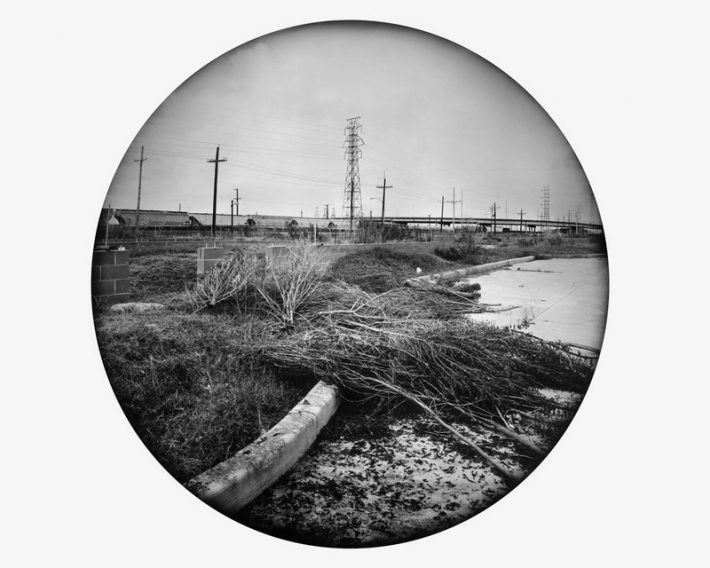by Adam Parker, via postandcourier.com

Florida Avenue and Congress, April 2008. (From “Tooth for an Eye: A Chorography of Violence in Orleans Parish.”)
Deborah Luster, a photographer from Louisiana, was named the 2015 winner of the 1858 Prize for Contemporary Southern Art, an award bestowed by the Gibbes Museum of Art.
Luster’s was one of 250 entries, and she was among five other finalists: Aldwyth of South Carolina; Andrea Keys Connell of Virginia; Kevin Jerome Everson of Virginia; George Jenne of North Carolina; and Jamaican-born Ebony G. Patterson of Kentucky.
The 1858 Prize for Contemporary Southern Art is awarded annually to an artist “contributing to a new understanding of art in the South” and comes with a cash prize of $10,000.
“We are thrilled to name Deborah Luster the 2015 winner of the 1858 Prize,” said Pam Wall, curator of exhibitions for the Gibbes Museum and a member of the panel of judges. “She is an incredibly gifted photographer who tells powerful stories through her work. Her portraits of prisoners are particularly stunning, capturing each individual with haunting beauty.”
Other judges were Charles Ailstock, Society 1858 board member; Jamieson Clair, Society 1858 board president; Sonya Clark, artist and last year’s winner of the 1858 Prize; Miranda Lash, curator of contemporary art at The Speed Art Museum in Louisville, Ky.; Cary Levine, a professor at the University of North Carolina at Chapel Hill; and Mark Sloan, director and chief curator of the Halsey Institute of Contemporary Art.
Luster, 64, didn’t start out as an artist. She studied literature in college, did a little writing and dancing and merely dabbled in photography and film. After her mother was murdered by a contract killer in 1988, Luster struggled to develop a strategy to deal with the trauma.
“I found taking photographs and doing projects the most effective way of dealing with it,” she said.
She turned her eye, and her lens, to the cracks and fissures of American society in Louisiana, concentrating on those who are forgotten, striving to inject the image with a dose of humanity.
Killers, after all, are people.
Luster spent much of the next couple of decades working on two big projects. The first, called “One Big Self: Prisoners in Louisiana,” a catalogue of inmates at the state’s prisons, including the notorious maximum-security facility at Angola. She collaborated with poet C.D. Wright.
In the published monograph, she admits to the mysterious compulsion of the artistic process.
“I cannot explain the need I feel (to produce this work) because I do not fully understand it myself. I only know that it has something to do with the formal quality of loss and the way we cannot speak directly to those who have gone — how to touch the disappeared. I need an aesthetic equivalent to the endless and indirect formality of loss.”
The images are striking in that Luster has stripped out all prison context, leaving only the individual subject.
“I wanted to look at people who are occupying our prisons as individuals,” she said.
Each of the prisoners volunteered for the portraits in exchange for a handful of small prints they planned to distribute to family and friends.
They were given little or no direction by Luster. “They weren’t really posing for me,” she said. “I think they were posing for the people they were planning to send their pictures to, their mothers and wives and children. So, consequently, the photographs are much better, because they’re posing for someone they love rather than some stranger.”
The second project is called “Tooth for an Eye: A Chorography of Violence in Orleans Parish.” (Chorography is the art of describing or mapping a region or district, according to Merriam-Webster.)
In this case, Luster again decided to concentrate her camera on violence — or, rather, the shadow of violence.
She divided New Orleans into sections, charted homicide locations she read about in the newspapers on a Google map, then examined those areas, sometimes talking with local people to learn more about the crime and the criminal before settling on her subject: a street corner, a telephone pole, a glass door, an overgrown lot.
She framed the shots within a circle, softening the hard edges of her city, and she used long exposures to blur all that which is transient. The images, she said, are about the idea of violence, and the absence that results from violence.
Recently, she secured a Robert Gardner Fellowship in Photography from the Peabody Museum of Archaeology and Ethnology at Harvard University. She will return to Angola prison to spend a year creating a portrait of the place, all 18,000 acres.
